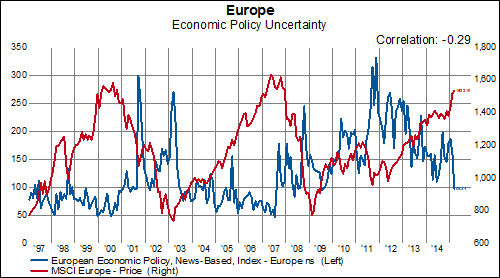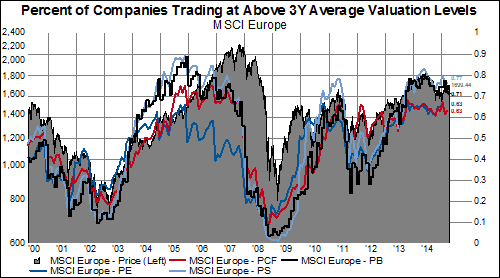Market-cap weighted indexes such as the MSCI global equity indexes are commonly used reference points for investment benchmarking. In these indexes, the market cap of the top 10% of the stocks is generally 50% of the market cap of the index. If we looked a normal distribution of the market cap of stocks in the global markets, we would see a tremendous amount of skew. The bell shaped curve would look like it got hit from a blast of wind from the left, exhibiting negative skew, where the left tail is much larger than the right tail. An easy way to spot negative skew in a distribution is to note if the mean is larger than the median. For the MSCI World index, the weighted mean market cap is $96 billion and the median is $11 billion. The skewness of this distribution is huge.
Why bring this up? Because, we invest our portfolios on a more or less equal weighted basis, where each position is roughly the same. In other words, the distribution of weighted market cap in our portfolio has much less skew. So, when we think about managing portfolios and identifying the data we need/want to try to beat the market, we want our data to fit our style of management. For us, data representing an index with a tremendous amount of skew is somewhat unhelpful when managing a portfolio with relatively little market cap skew. We think of it from a probabilistic standpoint. We want to know information relevant to our odds of picking a stock from a certain industry that will outperform the index. Information about the performance of the market weighted index isn't so helpful in determining whether or not the odds of a picking an outperforming stock are high or low.
How about an example? In the chart below is a picture of the market cap weighted MSCI World Household & Personal Products Index relative to the (market cap weighted) MSCI World index.

One would look at this chart and not be impressed with year-to-date performance. But, the interesting thing is that the equal weighted average household and personal products company is up 8.4% YTD, outperforming the MSCI World index by 4%.
MSCI World Industry Group Performance (equal weighted)
 MSCI World Industry Group Performance (equal weight) Relative to MSCI World Index
MSCI World Industry Group Performance (equal weight) Relative to MSCI World Index

If we look at the breadth of performance in the industry, we can see that household/personal products industry exhibits the second best breadth of all industry groups, with 76% of the companies outperforming. This suggest that our odds of a picking an outperforming stock are very high in this group. This should be an obvious area of interest for investors.
MSCI World Industry Groups Percent of Companies Outperforming the MSCI World Index

Drilling down to the individual names, we can easily that the outlier is Proctor and Gamble. P&G is down 4.4% YTD.
MSCI Household/Personal Products Performance

Since P&G alone is roughly half the market cap of the industry with 11 members, this is a great example of how the top 10% of an index represents roughly 50% of the market cap.
MSCI Household/Personal Products Market Cap

Market cap weighted indexes are great for some applications but not so great for others. If your goal is to actively manage a portfolio of stocks with the aim of beating the market, then a market cap weighted index isn't so useful. One has to have the right tool for the job.















































